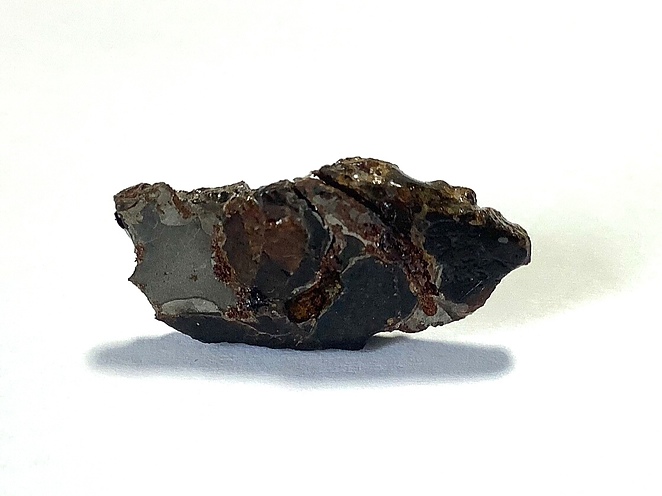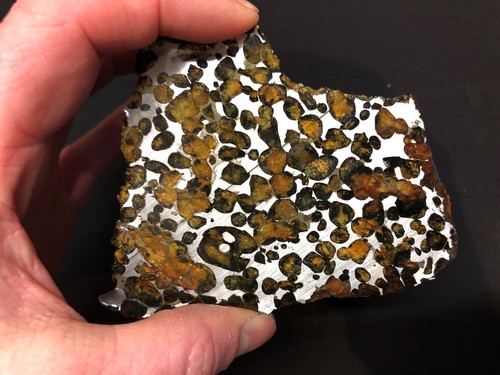PMG pallasite meteorite
A rock classification type
This page is currently not sponsored. Click here to sponsor this page.
About PMG pallasite meteorite
Name:
The acronym PMG was proposed by Wasson and Choi (2003) in substitution of the previously used PAL.
A pallasite belonging to the main chemical group. Metal compositions in all PMG are closely related to those in evolved IIIAB irons, and are generally consistent with their formation in the IIIAB parent asteroid. The O-isotope composition of their olivine (forsterite) is a main parameter to separate the main-group pallasites (PMG) and Eagle-Station pallasites (PES). The mean PMG ∆17O (=δ17O-0.52·δ18O) value is -0.28 ± 0.06‰. The mean PES ∆17O value is much lower, ≈-4.6‰.
The major mineral assemblages of most PMG are quite simple, consisting of troilite and schreibersite in addition to olivine (forsterite), kamacite and taenite; olivine Fa values range from 11 to 18 mol%, with >80% of the values in the range 11.6–13.5 mol% (Buseck and Goldstein, 1969). Zaisho (Fa18.3) has the highest Fa among PMG (Buseck and Clark, 1984). In addition, several characteristic minor minerals have been reported. Chromite is relatively abundant; some grains have euhedral shapes and seem to have crystallised from a melt (Buseck, 1977). A few chromites are quite massive; a large (10-cm) chromite-olivine assemblage in Brenham was described in detail by Wasson et al. (1999). Phosphates are minor phases in all PMG (common only in Springwater); the identified phosphates are farringtonite, stanfieldite, and merrillite (Buseck and Holdsworth, 1977). Phosphoran olivine is rare in most pallasites but minor amounts may be ubiquitous in the more oxidized PMG (Buseck, 1977; Buseck and Clark, 1984). Low-Ca pyroxene is a rare accessory phase (Buseck, 1977).
Some PMG are assigned to an anomalous subset (PMG-an) because of their anomalous properties (deviant metal compositions or appreciably higher olivine Fa contents).
The major mineral assemblages of most PMG are quite simple, consisting of troilite and schreibersite in addition to olivine (forsterite), kamacite and taenite; olivine Fa values range from 11 to 18 mol%, with >80% of the values in the range 11.6–13.5 mol% (Buseck and Goldstein, 1969). Zaisho (Fa18.3) has the highest Fa among PMG (Buseck and Clark, 1984). In addition, several characteristic minor minerals have been reported. Chromite is relatively abundant; some grains have euhedral shapes and seem to have crystallised from a melt (Buseck, 1977). A few chromites are quite massive; a large (10-cm) chromite-olivine assemblage in Brenham was described in detail by Wasson et al. (1999). Phosphates are minor phases in all PMG (common only in Springwater); the identified phosphates are farringtonite, stanfieldite, and merrillite (Buseck and Holdsworth, 1977). Phosphoran olivine is rare in most pallasites but minor amounts may be ubiquitous in the more oxidized PMG (Buseck, 1977; Buseck and Clark, 1984). Low-Ca pyroxene is a rare accessory phase (Buseck, 1977).
Some PMG are assigned to an anomalous subset (PMG-an) because of their anomalous properties (deviant metal compositions or appreciably higher olivine Fa contents).
Meteoritical Society Code: Pallasite, PMG
Unique Identifiers
Mindat ID:
49899
Long-form identifier:
mindat:1:1:49899:1
GUID
(UUID V4):
(UUID V4):
40f41c7d-0ab9-4a01-89d8-e8f004aed9a8
Classification of PMG pallasite meteorite
- Rock
- Meteorite and other extra-terrestrial rock and sediment
- Meteorite
- Differentiated achondrite meteorite
- Pallasite meteorite
- PMG pallasite meteorite
- Pallasite meteorite
- Stony-iron meteorite
- Pallasite meteorite
- PMG pallasite meteorite
- Pallasite meteorite
- Differentiated achondrite meteorite
- Meteorite
- Meteorite and other extra-terrestrial rock and sediment
Sub-divisions of PMG pallasite meteorite
- PMG pallasite meteorite
Mineralogy of PMG pallasite meteorite
Essential minerals - these are minerals that are required within the classification of this rock:
| Meteoritic Iron | Iron found as a constituent of meteorites. |
| Olivine > Forsterite | Mg2SiO4 |
Non-essential minerals - these minerals are common, sometimes major components, but are not always present:
| Chromite | Fe2+Cr3+2O4 |
| Schreibersite | (Fe,Ni)3P |
| Troilite | FeS |
Synonyms of PMG pallasite meteorite
Common Associates
Associated Minerals Based on Photo Data:
| 8 photos of PMG pallasite meteorite associated with Forsterite | Mg2SiO4 |
References for PMG pallasite meteorite
Reference List:
Sort by Year (asc) | by Year (desc) | by Author (A-Z) | by Author (Z-A)
Buseck, P.R., and Goldstein, J.I. (1969) Olivine compositions and cooling rates of pallasitic meteorites. Bulletin of the Geological Society of America, 80, 2141–2158.
Buseck, P.R. (1977) Pallasite meteorites - Mineralogy, petrology, and geochemistry. Geochimica et Cosmochimica Acta, 41, 711-740.
Buseck, P.R., and Holdsworth, E. (1977) Phosphate minerals in pallasite meteorites. Mineralogical Magazine, 41, 91–102.
Scott, E.R.D. (1977) Geochemical relationships between some pallasites and iron meteorites. Mineralogical Magagazine, 41, 265–272.
Buseck, P.R., and Clark, J. (1984) Zaisho — A pallasite containing pyroxene and phosphoran olivine. Mineralogical Magazine, 48, 229–235.
Clayton, R.N., and Mayeda, T.K. (1996) Oxygen isotope studies of achondrites. Geochimica et Cosmochimica Acta, 60, 1999–2017.
Wasson, J.T., Lange, D.E., Francis, C.A., and Ulff-Møller, F. (1999) Massive chromite in the Brenham pallasite and the fractionation of Cr during the crystallization of asteroidal cores. Geochimica et Cosmochimica Acta, 63, 1219–1232.
Wasson, John T., and Choi, Byeon-Gak (2003) Main-group pallasites: Chemical composition, relationship to IIIAB irons, and origin. Geochimica et Cosmochimica Acta, 67, 16, 3079–3096; doi:10.1016/S0016-7037(00)00306-5
Internet Links for PMG pallasite meteorite
mindat.org URL:
https://www.mindat.org/min-49899.html
Please feel free to link to this page.
Please feel free to link to this page.
Recorded finds for PMG pallasite meteorite
Locality List
 - This locality has map coordinates listed.
- This locality has map coordinates listed.
 - This locality has estimated coordinates.
ⓘ - Click for references and further information on this occurrence.
? - Indicates mineral may be doubtful at this locality.
- This locality has estimated coordinates.
ⓘ - Click for references and further information on this occurrence.
? - Indicates mineral may be doubtful at this locality.
 - Good crystals or important locality for species.
- Good crystals or important locality for species.
 - World class for species or very significant.
(TL) - Type Locality for a valid mineral species.
(FRL) - First Recorded Locality for everything else (eg varieties).
- World class for species or very significant.
(TL) - Type Locality for a valid mineral species.
(FRL) - First Recorded Locality for everything else (eg varieties).
All localities listed without proper references should be considered as questionable.
Antarctica | |
| Meteoritical Society Database |
Argentina | |
| Meteoritical Society Database |
Australia | |
| Meteoritical Society Database |
| [Anomalous PMG pallasite meteorite] Meteoritical Society Database |
Belarus | |
| Meteoritical Society Database |
Brazil | |
| Meteoritical Society Database |
Canada | |
| Meteoritical Society Database |
| [Anomalous PMG pallasite meteorite] Meteoritical Society Database |
Chile | |
| Meteoritical Society Database |
China | |
| Meteoritical Society Database |
Italy | |
| Meteoritical Society Database |
| Meteoritical Society Database |
Japan | |
| [Anomalous PMG pallasite meteorite] Meteoritical Society Database |
Mexico | |
| Meteoritical Society Database; Fuchs, L. H. (1967). Stanfieldite: a new phosphate mineral from stony-iron meteorites. Science, 158(3803), 910-911. |
| Meteoritical Society Database |
Northwest Africa | |
| Meteoritical Society Database | |
Norway | |
| Meteoritical Society Database |
Russia | |
| [Anomalous PMG pallasite meteorite] Meteoritical Society Database |
| Meteoritical Society Database |
| Meteoritical Society Database |
| Meteoritical Society Database |
| Meteoritical Society Database |
| Meteoritical Society Database |
USA | |
| Meteoritical Society Database; Buseck, P. R. (1968). Mackinawite, pentlandite, and native copper from the Newport pallasite. Mineralogical Magazine, 36(281), 717-725. |
| [Anomalous PMG pallasite meteorite] Meteoritical Society Database |
| Meteoritical Society Database |
| Meteoritical Society Database |
| Meteoritical Society Database |
| Meteoritical Society Database |
| [Anomalous PMG pallasite meteorite] Meteoritical Society Database |
| Meteoritical Society Database |






 symbol to view information about a locality.
The
symbol to view information about a locality.
The 



Isiolo County, Kenya